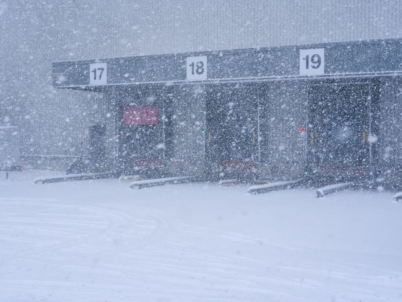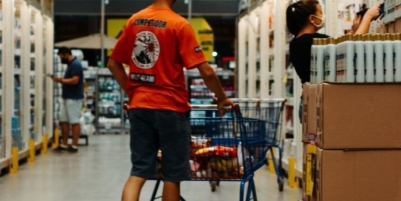-
AI startup Onton raises $7.5M to reinvent the way the world discovers and decides what to buy - November 26, 2025
-
Forklift Market Positions for Recovery as Confidence Expected to Build from 2026 - November 26, 2025
-
PROCare achieves 300% order capacity increase and 99% picking accuracy with Forterro’s ERP solution, Orderwise - November 26, 2025
-
DHL boosts operational efficiency and customer communications with HappyRobot’s AI Agents - November 25, 2025
-
STENA LINE TEAMS UP WITH CAMERA TELEMATICS TO DRIVE SAFETY IMPROVEMENTS AT IRISH SEA PORTS - November 25, 2025
-
Another design award for Toyota’s lithium-ion Traigo_i counterbalanced forklift - November 21, 2025
-
Stuut Technologies Raises $29.5 Million Series A Led by Andreessen Horowitz to Automate Accounts Receivable Work - November 20, 2025
-
INCREASED DIGITAL INVESTMENT REQUIRED TO KEEP PACE WITH 2026 CUSTOMS CHANGES - November 19, 2025
-
FULFILMENT SOLUTIONS FOR SPORTS MERCHANDISE: KEEPING OUR EYE ON THE GAME - November 19, 2025
-
COMPLEX, COSTLY & CONFUSING – THE END OF DE MINIMIS - November 19, 2025
Automation offers a route forward for hard-pressed e-fulfilment operations – particularly, when it comes to packaging processes. But how do you build in operational resilience? What are the secrets to maximising uptime? By Will Carder, Automation Sales Engineer at Quadient

The pandemic has turned the retail sector on its head. Online order volumes rocketed by 36% over 2020 and look set to remain high, pure-play fashion brands are buying up beleaguered high-street names and labour issues wrought by Brexit and stringent social distancing requirements have exposed the shortcomings of manual fulfilment operations.
Faced with these challenges, many pure-play and omni-channel retailers are, for the first time, turning to automation as a means to boosting performance within their fulfilment processes. Technologies being adopted may take the form of mobile robots, pick-to-light technology, cross-belt sorters and fast, automated packaging solutions. But, for those unfamiliar with automated systems, the prospect of relying on machines is daunting – what if they breakdown? How do you reduce exposure to risk?
Understanding how to maximise uptime is critical to the success of any automation project. It helps protect future operational performance and in addition, it’s an essential step to instilling confidence and attaining senior management endorsement.
A sophisticated automated system can be a significant financial commitment, with a return on investment (ROI), even on a low CapEx project, typically running at around 18 months or so. Protecting that investment and ensuring a good early ROI depends on the efficiency of the applied technology, its durability/reliability and the competency of operators, technical staff and service support.
Businesses new to automation are unlikely to have resident maintenance engineers – and for a fairly modest level of automation an onsite engineer may not be necessary. But trained staff with some level of technical ability, backed up by good, responsive support from a systems vendor will be essential.
Looking specifically at advanced automated packaging solutions, there are highly sophisticated packaging systems available that can tailor-make individual cardboard boxes to the exact optimum size of the ordered item(s) at a rate of up 1100 packages per hour. These machines use 3D imagery to scan and then calculate, cut, fold and seal a precisely made box every three seconds – along with weighing each package and applying a carrier label.
These sophisticated machines deliver huge advantages in terms of fast, efficient throughput, savings on cardboard and void fill, increased trailer density and fewer vehicles on the road. But, of course, reaping the full benefits of this technology comes down to ensuring that maximum uptime is achieved across the year and importantly, maintained during peak periods.
Even with highly sophisticated fit-to-size packaging systems, such as Quadient’s CVP Everest and CVP Impack, achieving an average uptime of around 97% should not be difficult if five key factors are adhered to:
- Define responsibilities
At the outset it’s important to clearly define the responsibilities of the systems supplier and those of the customer. Much will depend upon the level of support a customer wishes to subscribe to, in terms of call-out response times and breadth of spare-parts to be held on site. Premium options reduce risk but must be balanced by available budget.
The supplier should ensure that the installation is executed efficiently and that high quality boxes are produced at the specified rate. Once commissioned, it’s important that operators are properly trained and that technical staff receive several hours of technical instruction.
- Provide adequate training
Operators are non-technical employees, so they should only be trained to levels required to operate the machine and correct minor issues such as a product fall in mid-process or to replenish supplies, like a new reel of cardboard, tape or labels etc. Beyond a small easily rectified error an on-site technician should be engaged.
In most instances the customer should be able to solve the problem. It may simply be a piece of cardboard that is causing an obstruction, which can easily be removed, or perhaps a spare part is required and, if stocked on site, can be quickly replaced by an on-site technician.
- Remote support
However, for more complex issues a remote support service should be called upon. Quadient offers a dial-up service where technicians offer expert advice and can remotely login to machines on a customer site to track faults and access data. All Quadient packaging systems have built-in sensors throughout and are equipped with video cameras strategically located at key points in the system. Analysis of logged data and captured images allow support engineers to pinpoint the cause of the problem, and in most instances, they can advise on-site technicians on how to resolve the issue.
- Call-out service
If necessary, the issue can be escalated to a service call-out, where a Quadient service engineer is dispatched to the client site. It’s important to understand the level of service support provided by your supplier from the outset. Quadient offers a premium ‘rapid response’ service, within hours – including at weekends. However, most businesses find that a next-day am response is adequate for their needs. Similarly, spare parts can be supplied within 24 hours, so parts held on site can be kept to a minimum.
- Scheduled maintenance
Of course, scheduled maintenance is of paramount importance and should be carried out by competent, fully qualified service engineers. Quadient insists that expert Quadient engineers carry out regular, scheduled preventative maintenance, which may be three times a year for a system producing 750,000 packages per annum.
However, the most critical factor relating to uptime is to make the right buying decision. Select a system that has proven reliability, which has been engineered to exacting standards, using only the most reliable ‘A’ grade components. In addition, look for a vendor that has invested in developing the technology and that has a track record for achieving excellence.
Confidence in maintaining the highest packaging performance depends on selecting a leader in packaging technology.
Details on Quadient’s advanced packaging systems and full service offerings are available at https://packagingbyquadient.com

































